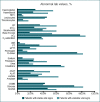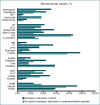The use of routine laboratory testing in acute trauma care: A retrospective analysis
- PMID: 35775666
- PMCID: PMC10493847
- DOI: 10.14744/tjtes.2021.14826
The use of routine laboratory testing in acute trauma care: A retrospective analysis
Abstract
Background: In more than 60 countries worldwide, laboratory testing plays a challenging and expensive role in trauma resus-citation. In 1995, the literature already suggested that routine laboratory testing may not be useful for most trauma patients. Our study hypothesized that still the need for some laboratory tests perhaps should be reconsidered. Therefore, the aim of this study was to create more insight in the distribution between normal and abnormal parameters for routine laboratory testing in trauma patient management.
Methods: This retrospective analysis was performed at Amsterdam UMC, location AMC, an academic level 1 trauma center. Data concerning age, gender, American Society of Anesthesiologists (ASA) physical state classification system (ASA), Injury Severity Scores, Glasgow Coma Scales, mechanism of injury, presence of high-energy trauma, and type of injury (blunt or penetrating) were obtained. Laboratory parameters included comprehensive hematology, coagulation, arterial blood gas, kidney, and liver blood panels. Analytical focus was paid to the patient's vital status, the indication for an emergency intervention, and the risk of in-hospital mortality.
Results: A total of 1287 patients were included in the study. Patients with unstable vital signs or who required emergency inter-vention were most often dealing with abnormalities in pO2, glucose, D-dimer, creatinine, and alcohol values. Mean corpuscular volume (MCV), international normalized ratio (INR), fibrinogen, and amylase were obtained in more than 80% of the patients, but in specific patient groups only abnormal in less than 9%.
Conclusion: Trauma patients suffer mainly from abnormal values of D-dimer, pO2, glucose, creatinine, and alcohol. By contrast, MCV, INR, amylase, fibrinogen, and thrombocytes are regularly obtained as well, but only abnormal in a small amount of trauma patients. These findings suggest reconsiderations and more accuracy in the performance of laboratory testing, especially for trauma patients with stable vital signs.
Conflict of interest statement
Figures



Similar articles
-
Impact of initial coagulation and fibrinolytic markers on mortality in patients with severe blunt trauma: a multicentre retrospective observational study.Scand J Trauma Resusc Emerg Med. 2019 Feb 28;27(1):25. doi: 10.1186/s13049-019-0606-6. Scand J Trauma Resusc Emerg Med. 2019. PMID: 30819212 Free PMC article.
-
Utility of routine laboratory testing for detecting intra-abdominal injury in the pediatric trauma patient.Pediatrics. 1993 Nov;92(5):691-4. Pediatrics. 1993. PMID: 8414856
-
Cost savings associated with changes in routine laboratory tests ordered for victims of trauma.Am Surg. 2000 Jun;66(6):579-84. Am Surg. 2000. PMID: 10888135
-
Elevated admission international normalized ratio strongly predicts mortality in victims of abusive head trauma.J Trauma Acute Care Surg. 2016 May;80(5):711-6. doi: 10.1097/TA.0000000000000954. J Trauma Acute Care Surg. 2016. PMID: 27100929
-
Point-of-Care International Normalized Ratio (INR) Monitoring Devices for Patients on Long-term Oral Anticoagulation Therapy: An Evidence-Based Analysis.Ont Health Technol Assess Ser. 2009;9(12):1-114. Epub 2009 Sep 1. Ont Health Technol Assess Ser. 2009. PMID: 23074516 Free PMC article.
Cited by
-
Admission Blood Glucose Level with a Cutoff Value of 15 mmol/L Is a Reliable Predictor of Mortality in Polytraumatized Patients-a Prospective, Observational, Longitudinal Study From a North African Level One Trauma Center.Orthop Res Rev. 2025 Jan 29;17:43-54. doi: 10.2147/ORR.S503377. eCollection 2025. Orthop Res Rev. 2025. PMID: 39896097 Free PMC article.
References
-
- Chandler WL, Ferrell C, Trimble S, Moody S. Development of a rapid emergency hemorrhage panel. Transfusion. 2010;50:2547–52. - PubMed
-
- Callum JL, Rizoli S, Pendergrast J. Rapid laboratory testing for trauma patients:Where a perfect result may not be in the best interests of the patient. Transfusion. 2010;50:2529–32. - PubMed
-
- Hill AG, Hill GL. Metabolic response to severe injury. Br J Surg. 1998;85:884–90. - PubMed
-
- Moore FA, Sauaia A, Moore EE, Haenel JB, Burch JM, Lezotte DC. Postinjury multiple organ failure:A bimodal phenomenon. J Trauma Inj Infect Crit Care. 1996;40:501–10. - PubMed
-
- Nast-Kolb D, Waydhas C, Gippner-Steppert C, Schneider I, Trupka A, Ruchholtz S, et al. Indicators of the posttraumatic inflammatory response correlate with organ failure in patients with multiple injuries. J Trauma Inj Infect Crit Care. 1997;42:446–54. - PubMed
MeSH terms
Substances
LinkOut - more resources
Full Text Sources
